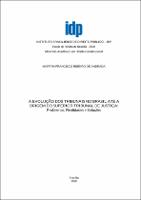Use este identificador para citar ou linkar para este item:
https://repositorio.idp.edu.br//handle/123456789/2991| Título: | A evolução dos tribunais no Brasil até a origem do Superior Tribunal de Justiça: problemas, realidades e soluções |
| Autor(es): | Andrada, Martim Francisco Ribeiro de |
| Orientador(es): | Wambier, Luiz Rodrigues |
| Palavras-chave: | Cortes;Tribunais no Brasil;Evolução histórica;Federação;Pacto Federativo;Influência Norte-Americana;União;Leis Federais;Competência;Superior Tribunal de Justiça;Cortes supremas |
| Data de submissão: | 2019 |
| Editor: | IDP/EAB |
| Citação: | ANDRADA, Martim Francisco Ribeiro de. A evolução dos tribunais no Brasil até a origem do Superior Tribunal de Justiça: problemas, realidades e soluções. 2019. 105 f. Dissertação (Mestrado em Direito Constitucional) – Instituto Brasileiro de Ensino, Desenvolvimento e Pesquisa, Brasília, 2021. |
| Resumo: | O presente trabalho busca analisar de forma pormenorizada a evolução das Cortes e Tribunais no Brasil, dando-se enfoque até a criação do Superior Tribunal de Justiça, que foi desmembrado do Supremo Tribunal Federal, em que ambos atuam conjuntamente na função de Tribunais da Federação.
Essa construção até o que temos hoje no Judiciário, em termos de Tribunais, é fruto desta evolução histórica, perpassando pelos problemas e dificuldades desde o período de Colonização. Além do já conhecido e talvez principal problema enfrentado pelos Tribunais (a excessiva quantidade material de processos), há outros fatores que influenciam diretamente neste número, dentre os quais está o nível de complexidade jurídica de cada caso em concreto, bem como a própria gestão processual pelas Cortes.
A partir, essencialmente deste ponto, decorrente do modelo federalista brasileiro, é que se busca debruçar e entender melhor a importância do equilíbrio democrático – que depende, essencialmente, da relação entre os três Poderes e a fiel observância das competências de cada um, principalmente após a vigência do pacto federativo, desde 1891, em nossa primeira Constituição. Com efeito, toda essa questão acerca do federalismo acaba repercutindo – inevitavelmente – nas Cortes Superiores, em especial no Superior Tribunal de Justiça, haja vista sua competência jurisdicional, que trata das Leis Federais.
A hipótese a ser aqui analisada, portanto, versa justamente sobre a situação real e vigente do Superior Tribunal de Justiça, em todo esse contexto, desde o problema da enorme diversidade e dimensão populacional, com sua multiplicidade cultural, passando também pela questão da excessiva carga de recursos, em razão da cultura da recorribilidade, até chegar no aspecto do federalismo, com a excessiva centralidade da União e enorme competência legislativa. Em virtude de tudo isso, onde se encaixaria, então, o papel específico e constitucional do STJ? Seria ele uma Corte de Justiça a mais ou uma verdadeira Corte de Cassação (Corte Suprema)? |
| Abstract: | This paper seeks to analyze in detail the evolution of the Courts in Brazil, focusing on the creation of the Superior Court of Justice, which was dismembered from the Federal Supreme Court, in which both act jointly in the function of Federal Courts. This construction up to what we have today in the judiciary, in terms of courts, is the result of this historical evolution, going through the problems and difficulties since the colonization period. Besides the already known and perhaps the main problem faced by the Courts (the excessive material amount of cases), there are other factors that directly influence this number, among which is the level of legal complexity of each specific case, as well as the procedural management itself, by the courts. From this point, essentially, as a result of the brazilian federalist model, we seek to better understand the importance of the democratic balance - which essentially depends on the relationship between the three Powers and the faithful observance of each other's competences, especially after the federal pact has been in force since 1891 in our first constitution. Indeed, this whole question about federalism inevitably resonates with the Superior Courts, especially the Superior Court of Justice, given its jurisdiction, which deals with Federal Laws. The hypothesis to be analyzed here, therefore, deals precisely with the actual and prevailing situation of the Superior Court of Justice, in all this context, from the problem of huge diversity and population dimension, with its cultural multiplicity, and also the issue of excessive burden resources, because of the culture of recurrence, to the point of federalism, with the Union's excessive centrality and enormous legislative competence. Because of all this, where would then fit the specific and constitutional role of the STJ? Was he a Court of Justice or a true Court of Cassation (Supreme Court)? |
| URI: | https://repositorio.idp.edu.br//handle/123456789/2991 |
| Aparece nas coleções: | Mestrado Acadêmico em Direito Constitucional |
Arquivos associados a este item:
| Arquivo | Descrição | Tamanho | Formato | |
|---|---|---|---|---|
| Dissertação_ MARTIM FRANCISCO RIBEIRO DE ANDRADA_MESTRADO EM DIREITO_2019.pdf | 797.71 kB | Adobe PDF |  Visualizar/Abrir |
Os itens no repositório estão protegidos por copyright, com todos os direitos reservados, salvo quando é indicado o contrário.
